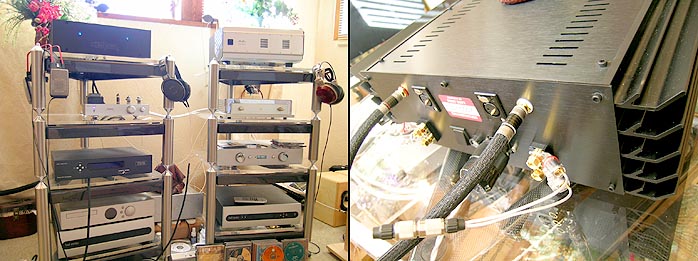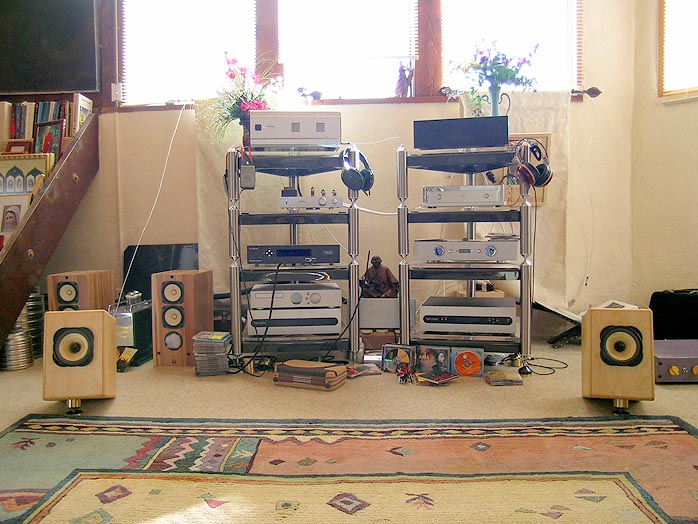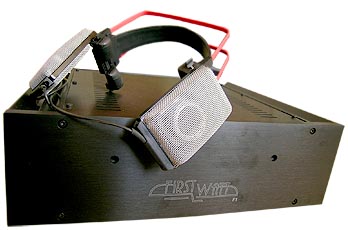 |
|||||||||||||||||||
| What did the Fostex Fe166e sound like in the Abbys once I had optimized their positioning and mated the F-1 to the MiniMax preamplifier? First off, most whizzer-fitted full-range drivers I've heard thus far do suffer varying degrees of peakiness. Depending on the cleverness of the designer fashioning an enclosure for them, this either gets tamed down to merely suggest a certain liveliness and energy or remains troublesome especially on charged female vocals. Terry Cain's neat speaker cabinet turns the 4kHz/4dB peak of his affordable Fostex driver into something that measures far worse than it sounds. Listening to Øystein Sevåg's and Lakki Patey's Visual [Windham Hill 01934 11182-2] with its tasteful synth pedals, solo guitar and piano and certain high-frequency effects was a very impressive demonstration of balance. While | |||||||||||||||||||
 |
|||||||||||||||||||
| the Abbys couldn't energize the room with certain bass drones I know from my Avantgardes, the whizzer cone of the Fostex unit did an amazing job of capturing the whizzing effects of "Old Man" with the synth-generated shards of broken glass twinkling in the sunlight or certain upper piano attacks reflecting off venue boundaries. I'd dare any first-time listener of this record to not be impressed with the F-1-driven Abbys. One would really be at a complete loss as to what else to expect if asked to point out any shortcomings. Naturally, transitioning to my $18,000 Avantgardes with active bass modules would reveal more of the subterranean trickery and certain of its wave-like surges cresting and breaking in the low 30s; and you'd occasionally hear more upper-harmonic spray; and certain drones would simply be sustained with more prominence and growling - but going back to the Abbys, you wouldn't at all feel like a bandaged cripple. |
|||||||||||||||||||
| In fact, even challenging female vocals like Dulce Ponte's Lagrimas [BMG 74321 25787 2] -- which can quickly expose a full-range driver's Achilles heel in the lower-to-mid-treble band -- only elicited very few and transitory glimpses of isolated prominence but even then never objectionably so. Truly, as far as full-range drivers go, this Fostex unit is one smooth and extended operator. Any whizzer jokes are not on the driver but the jokster who'll be exposed as a wheezing old-timer who hasn't kept up with them new and present times. To be honest, I'm not sure whether to feel more impressed by the Abbys' treble or bass performance. At the end of the day, I'll cop out and opt for 'overall balance'. That's really the most compelling reason for why to consider ownership of the Abbys. |
|||||||||||||||||||
 |
|||||||||||||||||||
 |
|||||||||||||||||||
Nobody in their right mind expects to buy a $1,500/pr speaker that does it all. What you get with the Abby if you build the system as described -- minus my front end which is criminal overkill in this scenario -- is a surprisingly warm-sounding speaker. At non-excessive listening levels, it's not zippy or tipped-up at all but rather, meaty and gutsy. Naturally, it's dynamic -- you expect that from a zero crossover design -- but it isn't hyper-dynamic like the Third Rethm which really is a speed freak of sorts. The Abby tracks dynamic swings very well and scales instantly but doesn't exaggerate this aspect to seem unnatural. Going to the most challenging of materials --classical symphonic -- you'd be surprised by how well this single driver sorts through the thicket of massive complexity. You'd really appreciate dynamic responsiveness when the first crescendos carry the climaxes farther than expected. |
|||||||||||||||||||
 |
|||||||||||||||||||
| Going all transistor -- something I ascertained with the Bel Canto Design PRe2 -- is not recommended, however. The F-1 is so clean, fast and accurate that the lack of the bottom octave in the Abbys requires a small infusion of fat elsewhere. That elsewhere is the tonal domain and now becomes the responsibility of the preamp. And there I have a hard time believing that you could do better than the hotrodded MiniMax for $900. If you wanted to go Bailey at a later point and add Terry Cain's aesthetically integrated subwoofer, the Eastern Electric piece gives you twin preouts so you're all set. Seeing that our resident chef John Potis is signed up to spill the cyber ink on Terry's new Super Abby (it merely adds a rear-firing horn-loaded ambient tweeter with user-adjustable attenuator over what I had), I shall leave the detailed reporting to him. I'll conclude today's Abby commentary with the following. Ed Schilling of the Horn Shoppe, Terry Cain of Cain & Cain and yours truly are unapologetic tube hounds and far more liable to experiment with some obscure valve amps nobody's ever heard of than give solid-state contenders from properly established makes much of a fair hearing. |
|||||||||||||||||||
 |
That said, Ed is so stoked by the F-1 that his Model 1 [left] currently at Nelson's has already been earmarked for a review by yours truly and with Nelson's amp. And despite Terry's predilection for rare 2A3 and 45 triodes -- preferably in one of Josh Stippich's outrageous creations -- he too is smitten as hell with the F-1 and, like me, fancies a valve preamp ahead of it. Nelson Pass is definitely on a hot track with his transconductance amplifier. Not for nothing do valve aficionados toss about terms like immediacy, tacitness and musical intimacy. When the F-1 mates with a speaker load for which it was designed, the same thing happens except that these effects don't come about as a function of THD or overload behavior but -- and now I'm stretching since this is new territory -- as a function of more precise coupling between signal and driver which eliminates fuzziness and indecision without killing off the spark or preventing notes from gushing forth or ringing out. There's nothing edgy, hyped or unnatural about the F-1 and into a truly full-range load like my AKG headphones, a solid-state preamp works splendidly. That surprisingly does not emphasize the peculiar zippiness these cans can dish out if mated to the wrong electronics. |
||||||||||||||||||
| The F-1 really makes an ultra-convincing argument for itself when you compare speaker outcomes within its respective circle vis-à-vis more conventional amplifiers. The mighty Butler amp cracks like a whip on my Gallos and the Hyperions and is growing our own Chip Stern a massive smile on his Josephs - yet it sounded strangely sluggish on the Abbys when compared to the FirstWatt. The 8wpc MiniMax amp in the nearfield works far better than expected on the Gallos yet was clearly out of its depth on the Cain & Cains once I heard 'em with the F-1. An 80-ohm output impedance on a standard speakers is a likely recipe for disaster. When mated to current drive and the intended loads, the results are disastrous only to your loyalties of common wisdom. |
|||||||||||||||||||
So don't mistake my tube-pre comments as suggestive of a lack in the F-1 that requires valves to become complete. My preference for the Eastern Electric over the Wyetech or Bel Canto units with the Abbys simply resulted from the speakers' relative lack of low bass foundation which becomes far less of an issue when tubes deliberately expand the harmonic envelope. Single-driver speakers require a bit more work than conventional multi-way designs to minimize their weaknesses via copasetic electronics and optimized room interaction. The reason you put up with their limitations in the first place are their strengths. Those attuned to them would have a mighty hard time duplicating them elsewhere. By necessity, they'd have to be minimum first-order designs to mimic the coherence and speed of single-driver designs and approach their dynamics. The Gallo Reference 3, Star Sound Technologies Caravelle and Green Mountain Audio Callisto and Continuum 3 come to mind - more expensive and full-range overall but with a clear family resemblance of core traits nonetheless. However, if you're truly sensitive to time domain issues and insist on the top-to-bottom coherence you otherwise only get from headphones, single-driver loudspeakers are your door to sonic bliss. Terry Cain's standard Abby gets a very strong recommendation for sonics and an abbysmal no-brainer one for low price and fine furniture appearance. Stay tuned to learn how it gets along with its Bailey subwoofer stablemate. |
|||||||||||||||||||
 |
|||||||||||||||||||
 |
|||||||||||||||||||
The same Strunz & Farah + bouzouki track managed to set off the port resonance of the $849/pr Omega loudspeakers and I opted to stuff the port with the earlier Polyfill, then move the speakers to the floor and angle them up at the listening position via Walker Audio Valid Points and resonance control discs to make up for the loss of bass extension. This worked like a charm but still cut out well before the optimally set-up Abby. Nelson had warned me that his outboard passive filters really rely on sealed alignments to create predictive results. The back-loaded quasi-horn of the Abby does benefit to a modest degree but the front-ported vented alignment of Louis' TS33 model didn't respond to any extent I could hear. No surprise really based on Nelson's warning but still a pleasing confirmation to obtain the same results. Swapping the F-1 for the Butler Audio 2250 as before, the Pass amp once again had the clear edge in speed and incisiveness and -- perhaps even more than on the Abby -- presented a more intelligible picture of what relatively little there was to be had down low. This followed the strange upside-down logic of the transconductance world where zero damping factor behaves as though it held plenty of zeros in reserve. So far, following Nelson's experimental detour into the wild corner of single-driver speakers had netted exactly what the man claimed himself in his lengthy white paper. So I was particularly curious about the DX-55 Lowther he had stuck into a sealed box to give me an opportunity to replicate some of his own testing when conditions for his compensation networks were optimum and supposed to give the most obvious results. (Incidentally, this plywood box isn't earmarked for commercial production. It's simply a manifestation of Nelson's experimental spirit and a one-upper.) |
|||||||||||||||||||
 |
|||||||||||||||||||
The Lowther and the Butler were a marriage made in hell. It made the speaker sound so unforgivably bright and strident that had this been your first and only Lowther encounter, you'd have written the brand off in all of 10 seconds of perfectly efficient character assassination. "The subject has been retired, sir. What's my next assignment?" Fortunately for Lowther, inserting the F-1 into the chain became a poster child for what the term day-and-night difference should imply. Holy crap. Had I not heard this for myself, I'd have called it impossible based on the first impression. The Lowther now exhibited all the speed, openness and crush-on-vocals it's known for, quite exceeding the Omega Fostex implementation in the clarity and communicativeness sweepstakes. But more importantly, rather than being shrill and relentless with no bottom end whatsoever, it now had bass the equal of the TSS3 - still not sufficient to really go the distance without a sub but no longer imbalanced, just a little light in the loafers and now with a truly glorious midband. Removing the network decomplished two things: the bass rolled off far earlier and the top end became hotter, the latter either just a function of upshifting the tonal center or also because the treble output had in fact increased. I couldn't determine from listening which of the two it was but the net result was the same - far less bass to make the presentation distinctly top-heavy. Having heard Jacob George's Second and Third Rethm, I know how much bass this driver can produce when loaded into an enclosure optimized for that goal. That it would produce less bass in Nelson's small box was no surprise. That there would be a considerable difference in bass quantity in my listening seat 12 feet away depending on whether or not the network was inserted was a big surprise. Some enterprising Lowther builder should team up with Nelson Pass. Build a floorstanding sealed DX-55 tower with this network hardwired to the driver and add this amp as part of the whole package. It could rewrite Lowther history as we know it. |
|||||||||||||||||||
 |
|||||||||||||||||||
So what did we learn? Simply put, read Nelson's white paper, then take it to the bank. The man knows his stuff and presents his findings in a scientifically accurate fashion that was readily repeatable on my end. His implementation of current drive does for single-driver speakers what balanced/bridged operation does for the Bel Canto Design eVo amplifiers. When the latter are bridged, it's not just that power triples. Far more importantly, the anti-phase boards of the bridged channels go into fully balanced operation which lowers the noise floor and ups the resolution without any sonic penalties. Feeding single-driver speakers with high-power amplifiers whose first watt sucks in such applications is clearly not the answer. Feeding such speakers with sufficient power from the usual tube suspects can be very copasetic indeed but based especially on my experience with Cain & Cain's Abby, the solid-state F-1 goes places where even they cannot go. If you fancy what tubes do in the tonal domain, simply precede the F-1 with a valve preamp of your choosing and you'll have the best of two worlds - control, precision and expanded bandwidth from the F-1, timbral girth from the preamp. Simply change your perspective. The control amp no longer is the usual preamp (controlling volume and input selection) but the power amp which truly controls the speakers and leaves sonic flavoring to the preamp. |
|||||||||||||||||||
| We are also reminded again how a one-size-fits-all recipe in audio doesn't exist. Every unique circumstance requires a unique solution and that's exactly what the FirstWatt F-1 amplifier is: a unique address on how to get single-driver speakers to behave more full-range and linear than they want to if left to other devices. If Pass Lab's history is any indication, this amplifier should essentially be bullet-proof and smartly outlive its first owners. And because it's true Class A and thus operates at 10% efficiency, it takes 100 watts from the wall to give 10 watts to the speakers. This translates as heat. It's not quite sufficient to fry eggs with but definitely sufficient to make picking it up -- and dropping it quickly after an hour's operation -- more elegant if you wore gloves or used your shirt sleeves to protect your hands. This is one hot operator both literally and | |||||||||||||||||||
 |
|||||||||||||||||||
| sonically. It's also limited to 100 owners which, considering how many single-driver devotees are essentially DIY types, seems about the right number to service those in this sector who'd rather own a turn-key solution. Who knows what specific scenario Nelson's forthcoming F-2 will address? One thing's for sure: this is one creative designer who is as comfortable in the mainstream as he is in a very small niche category. And that makes the F-1 into definite 6moons (and AKG K-1000) material. | |||||||||||||||||||
 |
|||||||||||||||||||
 |
|||||||||||||||||||
|
Manufacturer's website
|
|||||||||||||||||||
 |
|||||||||||||||||||